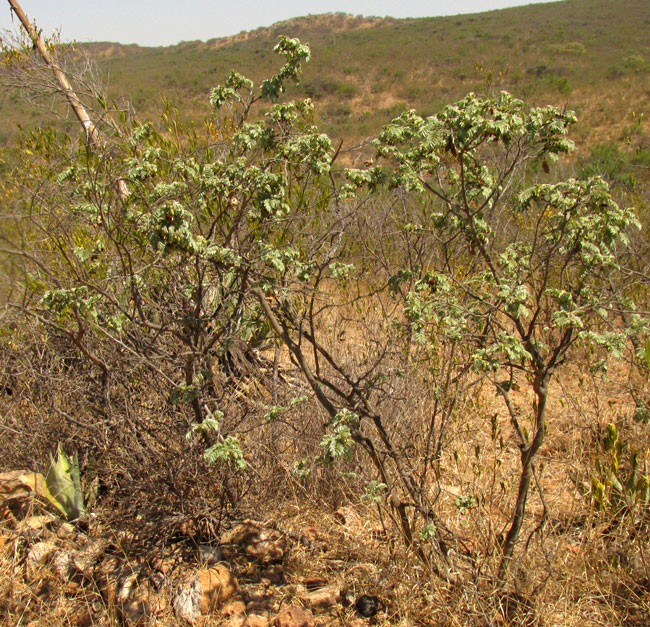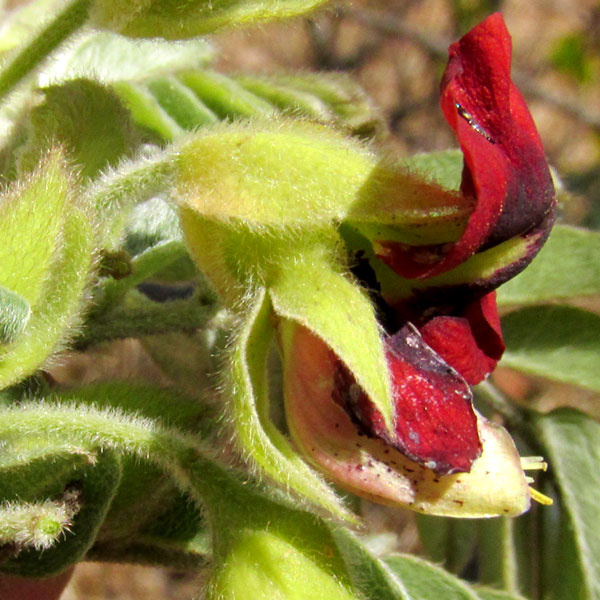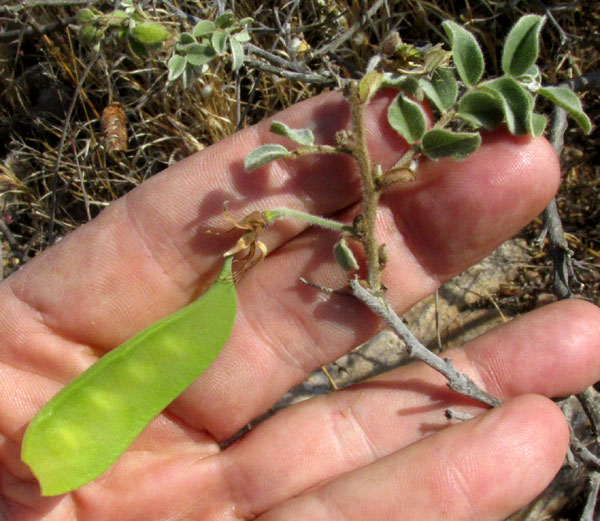Excerpts from Jim Conrad's
Naturalist Newsletter
entry dated May 19, 2022, notes from a camping trip among hills about 7kms ENE of Tequisquiapan, Querétaro state, MÉXICO
elevation about 2000m (6600 ft), near N20.57°, W99.85°
BRONGNIARTIA TREE

At the hot, dusty, glaringly sunny end of the dry season, the landscape here is mostly brown and gray. However, in anticipation of the rainy season, a few shrubs and small trees already are issuing new growth such as shown above, occurring at a branch tip of a tree about 2.5m tall (8ft). With those pinnately compound leaves and a blossom of the classic bean-flower shape, "papilionaceous" or "butterfly like" -- with a large top petal, two narrow side ones, and two lower petals (not visible in the picture) fused along their common margin into a scoop-like form. From this it's clear that our little tree belongs to the huge Bean Family, the Fabaceae.
Here's what the whole tree looked like:

From the side, the above flower shows good field marks for identification:

The upper corolla's burgundy color is a little unusual, plus note the greenish yellow spot at the base of the big top petal. The bottom petals are whitish. In the above picture, extending beyond the scoop shape formed by the united bottom petals you see the white tips of three of the ten white stamens, and the yellow, stigma-tipped end of the pistil's style. Also, all the vegetative parts are heavily invested with soft hairs giving the green parts a silvery hue, surely protecting the plant from intense sunlight and hot, drying-out wind.

The above picture shows the dried, curled-up remains of last season's legume-type fruits, the seeds or beans long discharged. It can be guessed that the original shape was something like that of lima or butter bean pods. On another tree of the same species found a little later in the same general area this was confirmed, for already on that tree this season's flowers had produced the pod shown below:

All the above details and more lead us to BRONGNIARTIA LUPINOIDES, endemic just to the semiarid uplands of central Mexico, and bearing no English name. Within that distribution, from about here in Querétaro south to Oaxaca, it's described as common, especially in disturbed parts of tropical deciduous forest (mesquite, acacia, etc.) and oak forest between 1750 and 2700m in elevation (5700-8900 feet).
This is one of those species for which -- in fact for the whole genus Brongniartia -- plenty of web pages mention the species' existence in long lists, there are technical descriptions in academic floras, and online you can see pressed herbarium specimens, but otherwise there's hardly anything giving a feeling for what the tree really is like.
But now, I can tell that Brongniartia lupinoides, out in its sun-parched gray and brown environment, offers a patch of greenness and friendly oxygen to all us breathers. It provides cool shade where it's needed, organic matter for the soil with its annual leaf fall, food for a spectacular population of gorgeous "Giant Mesquite Bugs" I frequently saw on this species and none other, and so much more.
Finally, Brongniartia lupinoides is yet another of those many species first noted by science when Humboldt and Bonpland passed through this area in 1803. They sent their dried and pressed collections to the German Botanist Karl Sigismund Kunth, who published the species description in Latin. In fact, in 1824, Kunth erected the genus Brongniartia just to include plants like ours being sent out of Mexico. Today the genus is recognized as containing about 58 species. It was named in honor of French botanist Adolphe Brongniart, whose work on the relationships between extinct plants found in fossils, and existing plants earned him the title of "father of paleobotany."